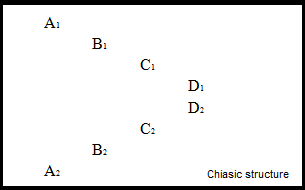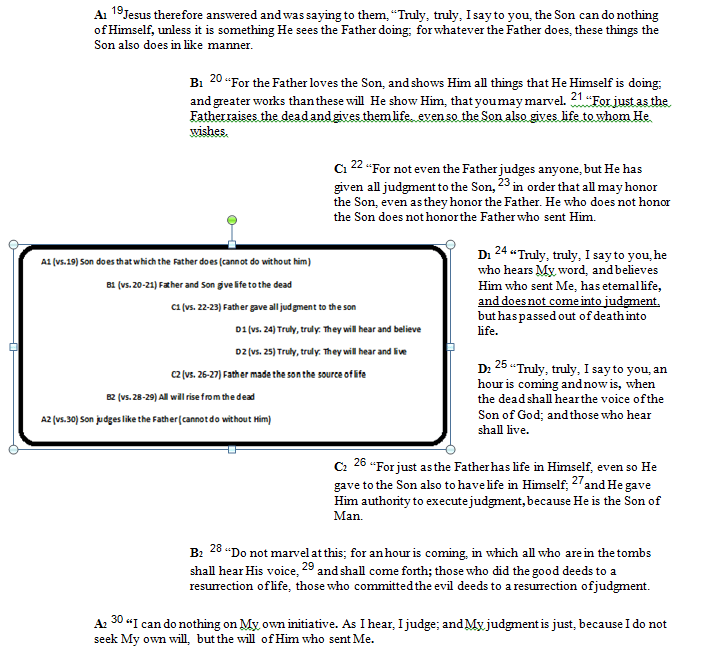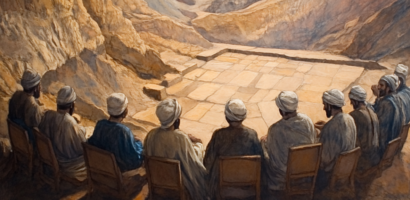Today we come to a very interesting text in John 5.19-30. If you have been reading this commentary carefully you may be surprised to find that I took such a long text for consideration all at once instead of dividing it up on many smaller pieces as I usually do. That is so, because here we meet an obvious and unquestionable example of an ancient form of literary design – chiasm and one of the many functions of chiasm is to help the interpreter to clearly see where the literary unit begins and where it is brought to a literary conclusion. It is easier to first show a diagram how chiastic structure looks like and then to attempt to explain it. The literary unit when analyzed has the following structure:
 The sentence either word by word or at the very list in thought by thought is repeated in the beginning and in the end of the literary unit. It is as if the original author goes from A1 to B1, from B1 to C1, from C1 to D1. But then all of the sudden the original writer of the text switches gears and moves backwards in the exactly the same order (D2, C2, B2, A2).
The sentence either word by word or at the very list in thought by thought is repeated in the beginning and in the end of the literary unit. It is as if the original author goes from A1 to B1, from B1 to C1, from C1 to D1. But then all of the sudden the original writer of the text switches gears and moves backwards in the exactly the same order (D2, C2, B2, A2).
If you have never heard of such a thing called chaism do not be alarmed, most people living in the modern times and reading modern literature have not. Yet a simple google search will uncover a huge literary and interpretive field that makes use of interpreting the Bible with the help of finding all kinds chiastic structures throughout the Bible seemingly omnipresent.
Before we even begin to wet our feet in the Chaistic interpretive ocean, please, allow me the privilege of a disclaimer. When it comes to finding chiasms in all imaginable places in the Bible I am a skeptic. I come kicking and screaming before I acknowledge that when looking at a given text we are indeed finding ourselves in the presence of chiasm. For example, many scholars have sought to show that the entire Gospel of John (not to mention other books) follow this kind of ancient literary bit, rhythm and structure – we today call chaism. Up until now, however, within my study of John I have not yet been persuaded that the Gospel of John is indeed structured as such, when it comes to its entire 21 chapters. I feel that often times interpreters tend to fit the biblical facts into their own theories and not vice versa as it should be.
However, after this lengthy disclaimer, by a chiastic skeptic like myself I must admit that I am finally persuaded that John 5.19-30 is indeed structured as a clear cut chiasm. Not only are thought-by-thought parallel repetitive structures are present, but my positive identification of it as a true (and not apparent) chiasm is safeguarded by word-by-word clear repetitive occurrences as well.
This week I would like you to get a basic grasp on what chaism means, next week I will show you how to interpret it responsibly. So make sure you come back in a week to see the update to this study. And, yes, you should be proactive and look up the word “chaism” or “chiastic structure” on the web. So here it is, can you see my point?
To receive more information about learning Biblical Languages with Hebrew University of Jerusalem/eTeacher Biblical program online at affordable cost, please, click here.
© By Eli Lizorkin-Eyzenberg, Ph.D.
To sign up for weekly posts by Dr. Eli, please, click here. It is recommend by Dr. Eli that you read everything from the begining in his study of John. You can do so by clicking here – “Samaritan-Jewish Commentary”.









I am quite happy reading the chiastic structure especially in the Gospel of John. It took me back to my theological studies on John too. Indeed the Johannine Corpus was composed according to the laws of chiastic parallelism rather than according to the laws of narrative. Chiastic parallelism of the Prologue, for examples offers us such a structural unit. In two units which share a number of parallel features, the first verse of I corresponds to the last verse of II, the second verse of I corresponds to the next to the last verse of II as Chiasm is a series (a,b,c) and its inversion (c,b,a) taken together as a combined unit.
Dear Chinedu, welcome to our study group. Blessings and peace, Dr. Eli
I found your studies by looking for some educational materials on the Gospel of John. You Chiasm diagram reminded me of a slide I put together to give to explain the effects of Adam and Eve’s Relationship with God as expressed thru the OT and NT all in under 2 minutes:
->They became convinced that their way was better than God’s
->->They became self-conscious and hid from God
->->->They tried to justify and defend what they did
In order to build a relationship with God, we must overcome the effects of Adam and Eve
<-<-<-We must drop every excuse and every justification
<-<-We must drop our pride and stop hiding from God, thinking He is unaware of what is going on
<-We must become convinced that God's way is better than ours.
What is the text of the chaism? 🙂 Thanks, Ryan.
Thank you for the explanation of chiasm. I have never read anything like that before. I have an English BA and have a terminology book. However, the more I hear and listen, the more I desire to proceed with studies. I am in Hebrew Unit B and shall soon be in the beginning Greek language. This study is very interesting. I do not understand why they call the Father, Son, and Holy Spirit the Trinity, but this lesson gives an interesting perspective on how to view the Father, Son, and Holy Spirit.
Thanks, Dolores! Keep up the good work with your studies with eTeacher! From Hebrew to Greek! Way to go! Dr. ELi
[…] в подробности. Если вы читаете по английски, то в этой статье можно увидеть хороший пример одной из разновидностей […]
[…] that this was the author’s intention and was part of his careful design that we saw earlier (Was the Gospel of John “simply” written or carefully designed?). One possibility is that John intentionally wanted us to know that conversations that began in […]
Dear DR Eli, Chiasm…a new word and a new understanding of the Word. Wow, this has really opened up the bible for me. Thank you
Rosina, let’s keep learning together!
Dr. Eli
Indeed, this is a topic that should interest any true student of historical theology and or interpretative methods of investigating the scriptures. It is much more exhilarating and edifying than such pursuits as structural criticism – although seemingly similar is much different. Additionally, such insight and understanding can truly help reveal the thoughts behind a text as well as the depth and scope of seemingly simplistic delineations of thought. Much has been propounded by scholars of all ages with respect to the workings and ideologies of the gospel of John. In some cases it has proved both perplexing and and challenging to the school of theology in general. This, then, is an important element of the makeup of this gospel message and the intent and purpose of the narrative for all audiences. I’m captivated by this tool…
Thanks Brother Eli,
For reminding me that I had learned these lessons some forty years ago ago in my studies of the Torah. You may address this in future studies but we are able with find without much effort this structure in e.g.
A. Genesis
B. Exodus
C. Leviticus
B. Numbers
A. Deuteronomy
And so on in the Prophets and in the Writings (Psalms).
One of my Hebrew professors indicated that only in the Divine Writ is this chiastic structure found. I was a rather young man at the time 15 or 16 and took his word on the matter.
Thanks again for reminding me that the first lessons are the most important.
Dr Denis O’Callaghan
Dear Dr. Denis, O’Callaghan, thank you as always for your comment. My only correction (I think I am accurate in this) is that chiasms are not found ONLY in Hebrew poetry. To my knowledge they are also present in such Hellenistic epic works as Odyssey and Iliad. Once again I do not know enough about the subject to be truly knowledgeable, only to be dangerous. 🙂 I think people did argue that God’s beautiful design is seen in the complexity of Holy Scripture’s composition. In a sense this a very Islamic argument (similar to the kinds of things that are said about suras of Q’uran). While I think that ultimately God does get all the credit, after all he gave and defined the very sense of what is beautiful, we must recognize that chiastic structures are characteristic of authorial (human) design as well. Yours as always, Eli
I am glad that Chiasm (or chiasmus) is being re-discovered in the North American academic scene. Coming from Latin America, as I do, I have done considerable work on NT texts utilizing Chiasm. It certainly helps in unraveling the meanings offered by the text…
Osvaldo Vena
Dear Dr. Osvaldo Vena,
many thanks for your comment. I am grateful for your participation in our study group and your general concern for justice and peace in the Middle East. Best wishes to you and your family in upcoming celebrations! Dr. Eli
[…] Last time we talked about an ancient literary device that we call today – chiasm. Before you read this section, make sure to review the prior (Click here to do so – Was the Gospel of John “simply” written or carefully designed?). […]